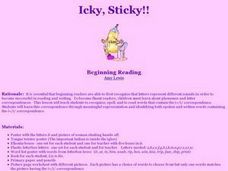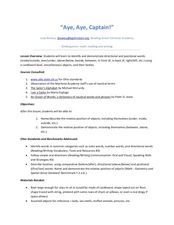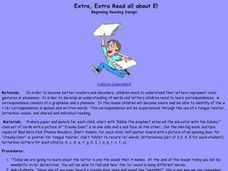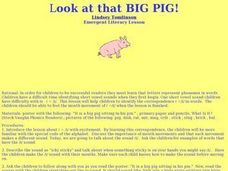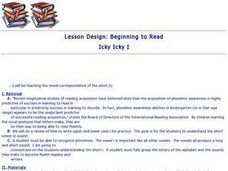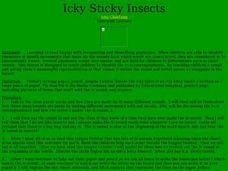Curated OER
First Day of School
Primary learners complete pre reading, writing, during reading, and interdisciplinary activities for the book First Day of School. They will complete journal entries, answer short answer questions, have discussions, and much...
Curated OER
Picture Match
Pupils match pictures with words that have specific phonics connotations. In this picture matching lesson plan, students have groups of words with the same phonics sayings.
Curated OER
Icky-Sticky
Students practice recognizing the connection between phonemes and letters with an emphasis on finding the short vowel /i/ in words. They each receive a Elkonin letterbox and a picture card with icky-sticky gum on it and the letter i.
Curated OER
Voicing and Syllable Length (Using Rubber Bands)
Students identify voiced and unvoiced sounds. They practice using short and long vowel sounds. They identify consonants only after paying attention to the length of vowels. They use rubber bands to help them determine the difference...
Curated OER
Ashley's Apples
First graders compare the /a/ sound to that of a baby crying. They practice making the sound and then say the tongue twister as it is written on a sentence strip and then using the overhead and letters, name words with that sound in them.
Curated OER
Say Aaaaa for Apple
Students say words by blending sounds and phonemes. They decode words in order to read and identify and understand the letter a. This phoneme /a/ is one of the short vowels that are needed to read and write. They will show example of...
Curated OER
The Fat Cat
Learners explore phonemes. They identify that a=/a/. Students recognize /a/ in spoken words by learning a meaningful representation and a letter symbol. Learners practice finding /a/ in a variety of words. Students read a book that...
Curated OER
Iggy and the Icky Sticky Inchworm
Students read and spell words. They have to recognize that letters stand for phonemes and spellings map out spoken words. Long and short vowels are hard to recognize and this lesson focuses on that. The short i is taught in the...
Curated OER
Grandpa Ed
Students engage in an emergent literacy lesson that focuses on phonemic awareness. For practice they become more comfortable with a short vowel phoneme, which can often be the most difficult to identify, by learning it in isolation.
Curated OER
Icky Fingers
Students are introduced to digraphs so they can match letters to their phonemes. They recognize the short vowel i=/i/ in both spoken and written words by practicing reading and spelling words containing /i/. Elkonin Letter Boxes are...
Curated OER
Aye, Aye Captain
Students investigate how correspondences appear differently in different words. They also recognize the difference between long and short vowels. Students study how these correspondences are spelled and pronounced differently.
Curated OER
Aaa, Alligators!!!
Students are introduced to different words that have the /a/ sound in them. They think of their own words that contain the sound and practice making the letter "a" on primary writing paper. Students who have formed the letter correctly...
Curated OER
Say it. Trace and Write in the O. Read it.
In this phonics worksheet, students identify nine pictures of items or activities that contain the short sound of o in them. Students trace the consonants in each word and write in the letter o.
Curated OER
Extra, Extra Read all about E!
Young scholars examine the letter 'e'. Through instruction and modeling they explore the sound the letter makes, how the letter is written, etc. They recite tongue twisters and use letterboxes to write 'e' words. They pick out short /e/...
Curated OER
Look at that BIG PIG!!!
First graders give examples of words that have the /i/ sound. They make the /i/ sound with their mouths and follow along as the poster is read which contains /i/ words. They read the poster together stretching out the /i/ sound and...
Curated OER
Language Arts: Sound Recognition
First graders practice the short i sound by repeating tongue twisters. Later they write the letter i by using the analogy of drawing a straight line from the "fence" down to the "sidewalk" and putting a "basketball" above it. Other...
Curated OER
Build it Up
First graders practice spelling words through by blending sounds with a focus on short vowels i and a. Through matching and listening activities, 1st graders replace initial and final sounds to create words they decode and read.
Curated OER
Icky Icky I
First graders review the letter "i" and use popsicle sticks and cotton balls to make upper and lower case "i's". Volunteers make the capital and lower case "i" on the board and then the class discovers the short sound that letter "i"...
Curated OER
Itchy Iggy
First graders observe the letter /i/ and the sound that it makes watching their mouths as the sound is formed. They say the tongue twister displayed repeating it three times; the last time they stretch out the /i/ sound as it occurs in...
Curated OER
Open Wide at the Dentist, "Aaaahh"
Study the /o/ in both written and spoken words by reciting a tongue twister and making words using Elkonin letterboxes. Next, write a message about frogs using /o/ words. Finally, listen to a short book talk on "Doc in the Fog" before...
Curated OER
What's Up Doc?
Students demonstrate the /o/ sound by opening up their mouth and saying, "Ahhhhh". They try saying a tongue twister that contains the /o/ phoneme; repeating it two times together. They then practice writing the letter /o/ so that it can...
Curated OER
Let's Read and Read!
Students discover how to hold their mouths to form the /o/ sound and that it may be hidden in different words. They say /o/ and then repeat a tongue twister that contains many /o/ words and practice writing it on primary lined paper....
Curated OER
Bless You
Students practice recognizing the phoneme /a/ in spoken and written words as well as by symbol. They interact with the book, "The Cat Nap," from Educational Insights and the Dr. Seuss book, "ABC's Book." Each student also plays a memory...
Curated OER
Icky Sticky Insects
Students discuss that words are made up of many different sounds. They make the /i/ sound pretending to see a big bug. They read a tongue twister that has several words with the same phoneme and stretch out the /i/ sound at the beginning...


